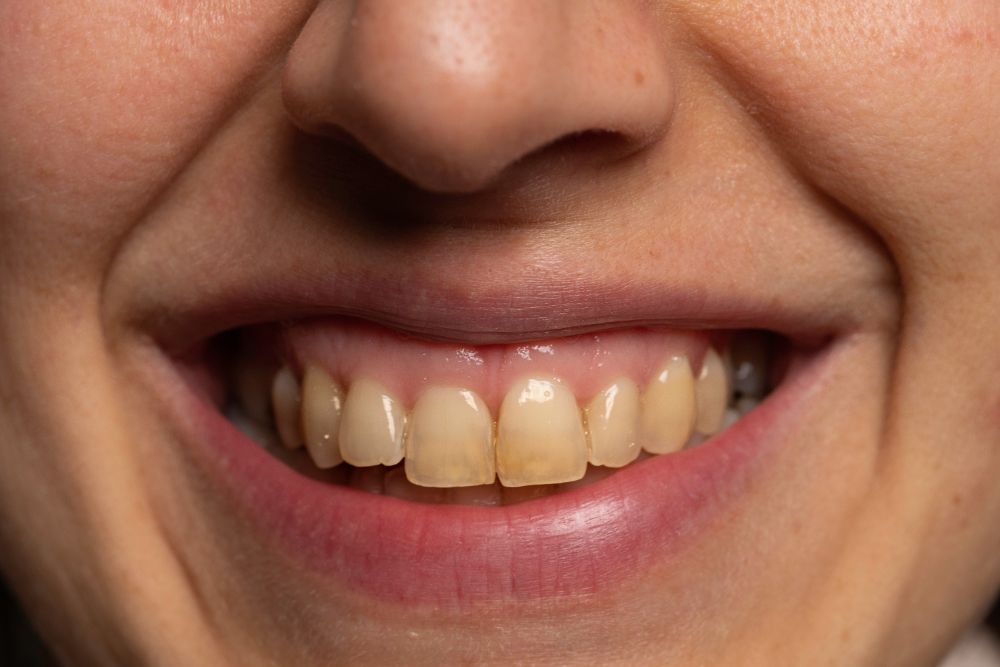Tooth discoloration occurs when the color of your teeth alters. They don’t appear as white or bright as they might. Your teeth might stain, darken from white to distinct shades, or grow white or dark spots in areas. Here are some things that may cause tooth discoloration.
Tooth Discoloration Causes
There are many sources of tooth discoloration, like:
Foods/drinks
Coffee, colas, tea, wines, or some vegetables and fruits (for example, potatoes and apples) may stain your teeth.
Tobacco Use
Chewing tobacco or smoking might stain teeth.
Poor Dental Hygiene
Not flossing, brushing, or rinsing sufficiently to reduce stain and plaque-making material.
Disease
Several sicknesses that affect enamel (the hardened textures of the teeth) or dentin (the foundational substance under enate me) might lead to tooth discoloration. Treatments for several conditions might additionally impact tooth color. For instance, neck and head chemotherapy and radiation lead to teeth discoloration. Additionally, several infections in pregnant mothers may result in tooth discoloration within their infants by impacting enamel growth.
Medications
The antibiotics tetracycline or doxycycline are reputed for discoloring teeth upon delivery to kids whose teeth still are developing (preceding age 8). Mouthwashes and rinses with chlorhexidine or cetylpyridinium chloride may additionally dirty teeth. Antihistamines (including Benadryl), antipsychotic drugs, or drugs for high blood pressure results in teeth discoloration.
Dental Materials
Several materials used in dentistry, which cover amalgam restorations, especially silver sulfide-holding materials, might cast a gray-black coloring upon teeth.
Aging
Once you mature, the outer layers of enamel on your teeth fade away, indicating the organic shades of dentin.
Genetics
Several individuals hold organically shinier or denser enamel than neighbors.
Environment
Too much fluoride from environmental origins (organically concentrated fluoride volumes within the liquid) or excess use (fluoride uses, toothpaste, rinses, or fluoride tablets taken orally) leads to teeth discoloration.
Trauma
For instance, damage from falls may disrupt enamel growth in kids with growing teeth. Trauma may lead to discoloration in mature teeth.
Tooth Discoloration Causes by Color
How the pigment of your teeth alters might assist with pointing to causes:
Yellow
Upon aging, the white enamel surfaces of your teeth might fade away. The yellow portions of your teeth become more apparent.
Brown
Tobacco, hot drinks, including coffee or tea, or bad brushing practices resulting in tooth decay might make teeth dark.
White
As early teeth grow, excess fluoride volumes lead to white spots. This is called fluorosis, which occurs when teeth get excessive fluoride levels from consuming water or excessive use of fluoride toothpaste or rinses.
Black
Tooth rotting or tooth pulp necrosis might render your teeth black or greyish. Eating betel nuts may then shade teeth dark. Exposure to chemicals, including manganese, iron, or silver, within industrial areas or from more supplements might generate some dark spots on your teeth.
Purple
Red wine might darken the enamels of your teeth with the colorings of your beverage.
Tooth Discoloration Prevention
Things you drink or eat that may leave a stain on your clothes or hands may additionally darken your choppers. That’s why it remains an excellent idea to rinse or darken your mouth upon you having taken these. Stain creators to look out for are:
- Coffee or tea
- Soda
- Soy sauce
- Red and white wine
- Grape or cranberry juice
- Blueberries
- Tomato sauce
- Beets
A few alternative lifestyle alterations help to stop teeth discoloration:
- If you’re a smoker or coffee drinker, try cutting down or ceasing.
- Drink using a straw. This may help ward off stains when taking juice, soda, tea, and iced coffee.

